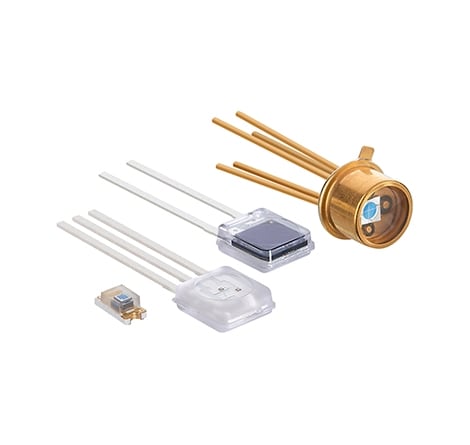
Sensores Ópticos
A linha de sensores ópticos robustos e acessíveis da TE Connectivity é adequada para uso em ambientes severos, onde precisão e confiabilidade são fundamentais. Nossos sensores são utilizados em automação industrial, sistemas avançados de assistência ao motorista (ADAS), medicina clínica não invasiva, navegação aeroespacial/de defesa, detecção e alcance de luz (LiDAR), bem como inúmeras outras aplicações.
Os sensores ópticos são usados em praticamente todas as facetas da sociedade moderna. Seja medindo velocidade e distâncias, interpretando gestos, medindo sinais vitais ou evitando colisões, as aplicações para esses sensores estão crescendo continuamente. Os sensores ópticos podem interpretar seus gestos em um dispositivo GPS quando você insere seu destino. Eles também guiam o satélite GPS, mantendo sua órbita para fornecer direções confiáveis. Em seu carro, fotodiodos ópticos são usados para ajudar a evitar colisões ao sair da garagem e medir a velocidade e as distâncias até o seu destino. Eles também garantem que você não saia da sua pista ou colida com um veículo em seu ponto cego. Em um ambiente clínico, os sensores ópticos ajudam a monitorar seus sinais vitais durante uma consulta médica. As comunicações de alta velocidade são facilitadas por sensores ópticos por meio de cabos de fibra óptica ou por ar, espaço ou vácuo usando a Comunicação Óptica de Espaço Livre (FSOC). Esses sensores podem até distinguir cores interpretando a frequência com que a luz reflete na superfície de um objeto. Os sensores de proximidade garantem a qualidade da maioria dos produtos de consumo, automatizando a montagem e a inspeção precisas.
Características do Produto
Baixa corrente escura
"Corrente escura" é um fenômeno natural que causa uma pequena corrente elétrica mesmo quando um fotodiodo não detecta luz. Em fotodiodos bem projetados, essa corrente gerada internamente é mantida ao mínimo. Isso melhora o desempenho do sensor, reduzindo o ruído e aumentando a precisão da detecção de luz.
Opções de Embalagem
Uma variedade de opções de embalagem está disponível na TE Connectivity para dispositivos de montagem em superfície (SMD) e dispositivos de orifício (THD) para atender às aplicações mais exigentes.
Embalagem para ambientes hostis
A TE Connectivity continua a desenvolver projetos robustos de pacotes de sensores e procedimentos de montagem que aumentam a resistência a ambientes corrosivos. Nossos sensores são projetados para suportar ambientes fabris severos, ajudando os fabricantes a melhorar a segurança dos trabalhadores, reduzir os custos de manutenção e aumentar a produtividade.
Soluções personalizadas
Nossa equipe global especializada e os recursos de engenharia dedicados estabeleceram a TE Connectivity como líder global em inovação de sensores. Oferecemos suporte e orientação desde o projeto conceitual até o produto final.
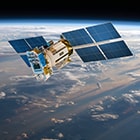
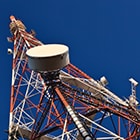
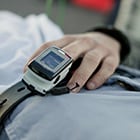
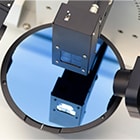
Aplicações do sensor óptico
Aeroespaço
Os Sensores solares solares são essenciais para os sistemas de navegação de espaçonaves. Esses instrumentos de navegação únicos detectam a posição do nosso Sol usando dados de dois eixos para orientar um satélite. Eles ajudam a fornecer controle de atitude e a orientar os painéis solares para máxima produção de energia. Esses dispositivos pequenos e leves podem ajudar a detectar falhas e identificar falhas de componentes, fornecendo informações sobre discrepâncias de dados. Eles são cruciais para a calibração de giroscópios a bordo e ajudam a permitir que os satélites recuperem o rumo após um mau funcionamento do sistema.
Comunicação de alta velocidade
- A comunicação por fibra óptica depende de fotodiodos para converter energia luminosa em energia elétrica proporcionalmente à intensidade da luz. Isso permite a transmissão de dados em alta velocidade por longas distâncias.
- A Comunicação Óptica em Espaço Livre (FSOC) permite a transmissão de dados sem fio, de alta velocidade e segura por ar livre, espaço ou vácuo. Como a fibra ótica, pulsos modulados de luz são transmitidos, transportando dados para um receptor.
Saúde
- Os termômetros infravermelhos detectam as emissões de radiação infravermelha de um objeto, transformando-as em um sinal elétrico que pode ser exibido como uma temperatura.
- A oximetria de pulso utiliza sensores foto-ópticos montados em uma sonda não invasiva, como um clipe ou uma banda. Dois LEDs com diferentes frequências de luz são passados pelos tecidos do paciente (ponta do dedo, lóbulo da orelha ou outro lugar) para determinar as quantidades de sangue oxigenado e não oxigenado. Com base nesses valores, a sonda pode calcular o teor relativo de oxigênio no sangue. Este método é usado em ambientes médicos em todo o mundo para monitoramento seguro, confortável e eficaz da oxigenação do sangue.
- Os têxteis inteligentes usam sensores de fibra óptica integrados para medir a tensão ou o deslocamento. Por exemplo, os instrumentos podem monitorar a respiração de um paciente medindo a tensão desses sensores. Um computador interpreta sinais elétricos, proporcionais à frequência de expansão e contração dos pulmões do paciente, como sua taxa de respiração. Essa tecnologia é importante para monitorar os sinais vitais de um paciente durante procedimentos de ressonância magnética em que sensores eletrônicos não podem ser utilizados.
Automação industrial
- Aslinhas de montagem incorporam sensores ópticos para verificar a posição, dimensão, composição e/ou alinhamento de componentes. Isso é fundamental para o processo de automação, pois facilita a montagem e a inspeção sem a necessidade de intervenção humana.
- Osautocolimadores são uma parte fundamental do processo de alinhamento ativo, que envolve o uso de óptica para otimizar a colocação de componentes, medindo o ângulo ou a intensidade da luz refletida. Esse processo ajuda a melhorar o desempenho do produto e reduzir os requisitos de precisão geométrica.
- A elipsometria tornou-se uma técnica óptica não destrutiva e sem contato para a análise de filmes finos. Essas camadas de material variam de frações de um nanômetro a vários micrômetros de espessura. Eles são usados para melhorar as propriedades dos componentes de peças de motores, semicondutores e até mesmo dos próprios sensores ópticos.
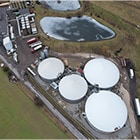

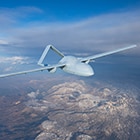
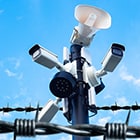
Energia Renovável
- A energia fotovoltaica (PV) é coletada por meio de fotodiodos, semelhantes aos usados em sensores ópticos, que convertem diretamente a energia luminosa em corrente elétrica. Cada fotodiodo pode gerar de 35 a 70 miliwatts em um dia claro e ensolarado. As células solares compostas por fotodiodos interconectados podem gerar de 1 a 5 watts. Essas células solares fotovoltaicas são então combinadas em redes e vendidas como painéis solares modulares que podem ser usados individualmente ou em painéis solares fotovoltaicos. O gerenciamento da luz para painéis solares fotovoltaicos pode ser obtido diretamente utilizando sensores solares ópticos para otimizar a orientação dos painéis solares. Os sensores ópticos também são usados para analisar a eficácia de lentes e espelhos projetados para concentrar a luz solar, melhorando o desempenho das células solares.
- As turbinas eólicas utilizam sensores ópticos para aumentar sua segurança, desempenho e confiabilidade. Esses dispositivos de baixo custo monitoram componentes críticos, fornecendo aviso antecipado sobre peças rotativas desequilibradas, bem como desgaste e fadiga do material. Esse monitoramento em tempo real promove a segurança, ajuda a evitar reparos dispendiosos e evita falhas mecânicas catastróficas. Os sensores de grade de fibra óptica medem a tensão, a temperatura e a curvatura das pás da turbina para manutenção preditiva e otimização do desempenho.
- A bioenergia é a terceira maior fonte de eletricidade renovável do mundo. Envolve a conversão de materiais orgânicos (biomassa) em energia por combustão, decomposição bacteriana ou gaseificação. Os sensores ópticos desempenham um papel crucial no monitoramento da produção de bioenergia, incluindo monitoramento contínuo, facilidade de uso, flexibilidade de design, risco reduzido de contaminação e integração com processos inteligentes.
- A tecnologia de captura, uso e armazenamento de carbono (CCUS) remove o carbono dos fluxos de exaustão dos sistemas de combustão e outros processos industriais. Sensores de absorção infravermelha e baseados em laser detectam e quantificam dióxido de carbono (CO2) e monóxido de carbono (CO) em fluxos de resíduos a montante e a jusante dos sistemas de captura de carbono. Sensores ópticos também são utilizados para monitorar o carbono atmosférico e outros poluentes, medindo o sucesso dos esforços de redução da poluição.
Produtos Farmacêuticos
- A descoberta de medicamentos é um processo utilizado para agilizar a identificação de novos medicamentos candidatos. Os biossensores ópticos podem ajudar na identificação de alvos para a descoberta de novos medicamentos, assim como na análise de interações biomoleculares em tempo real.
- Os biossensores ópticos são usados para detectar contaminantes no sangue, tecidos e medicamentos. Eles são essenciais para a segurança e eficácia dos produtos farmacêuticos e também para detectar bactérias, células tumorais, biomarcadores, drogas ou outras toxinas no sangue, tecidos e medicamentos.
Defesa e aplicação da lei
- ODry dire laser training é um método de praticar habilidades de tiro sem usar munição real. Envolve o uso de um cartucho de treinamento a laser ou armas de fogo fictícias que emitem feixes de laser precisos quando o gatilho é pressionado. O feixe de laser atinge o alvo, mostrando exatamente onde o tiro teria caído. Isso fornece um meio sustentável e econômico de melhorar as habilidades com armas de fogo, capturando dados sobre a exatidão e precisão dos usuários de armas de fogo.
- A aplicação da aplicação da lei aérea é uma utilização única de sistemas Eletro-Ópticos e Infravermelhos (EO/IR) que empregam drones equipados com sensores especializados para detectar e identificar alvos. Esses sistemas permitem a segurança dos transeuntes e da aplicação da lei enquanto os suspeitos são presos.
- Sistemas de detecção de disparos utilizam sensores acústicos e ópticos para identificar a origem e a localização dos tiros. Os sensores ópticos permitem uma resposta extremamente rápida a eventos de descarga de arma de fogo, detectando um flash de cano e estimando sua localização. Alguns sistemas utilizam luz infravermelha para melhorar o desempenho do sensor óptico em condições de pouca luz. Em certos casos, os sensores podem fornecer informações de velocidade e trajetória sobre o projétil, o que pode ajudar a identificar o tipo de arma disparada.
- Os Sistemas de vigilância de fronteira utilizam sensores ópticos para detectar movimentos e variações de temperatura que indicam a presença de organismos vivos. Os sistemas de visão noturna permitem que esses sistemas funcionem com pouca luz. O Sistema de Detecção Linear de Solo (LGDS) utiliza uma rede de sensores distribuídos interconectados por cabos de fibra óptica para localizar e classificar atividades, como pessoas, movimentação de veículos e aeronaves voando baixo. Escavações, tiros e outros eventos suspeitos também podem ser monitorados e investigados.
- Os navios de guerra navais usam sensores ópticos para melhorar a compreensão da tripulação sobre seu ambiente, avaliar alvos e permitir a sobrevivência da embarcação. Esses sensores ópticos são essenciais para detectar ameaças e alvos na superfície e no ar. Os sistemas de navegação autônomos, nos quais sensores ópticos são usados para ajudar a evitar colisões e permanecer no curso, são cada vez mais prevalentes na guerra naval.

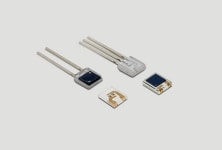 e
e
 e
e
